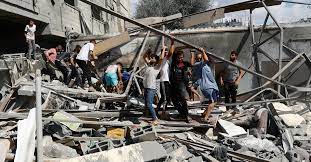
The Gaza Strip is mired in a deepening humanitarian crisis, with the United Nations issuing a dire warning about the deteriorating situation. Palestinian civilians in the region are finding themselves “packed into an ever-smaller area,” and the availability of life-saving essentials has all but run out. As a result, the UN has urgently appealed for a humanitarian truce to allow much-needed aid access to the embattled territory.
During a meeting convened by Arab envoys on the Gaza situation, senior U.N. aid official Joyce Msuya revealed the alarming scale of displacement. “It is now estimated that as many as 1 million people have fled their homes to other parts of Gaza,” she stated. This mass exodus comes in the wake of Israel’s decision to order approximately 1.1 million people in Gaza, nearly half the population, to move south. The Israeli move is seen as preparations for a ground offensive in retaliation for what has been described as the worst Hamas attack on Israeli civilians in the nation’s 75-year history.
“In reality, civilians have nowhere to go — nowhere to escape the bombs and missiles, and nowhere to find water or food, or to escape the unfolding humanitarian catastrophe,” Msuya emphasized. Her plea for a “humanitarian suspension of hostilities” underscores the dire need for an immediate truce to allow the delivery of aid and relief to Gaza’s beleaguered population.
The situation in Gaza has worsened as Israel has imposed a total siege on the territory and intensified its bombardment. Israel’s pledge to obliterate Hamas follows a devastating attack on Israel by the militant group on October 7, resulting in the deaths of approximately 1,300 people and the seizure of hostages. The conflict has taken a severe toll, with over 3,000 Palestinians losing their lives.
International diplomatic efforts are now centered on brokering a humanitarian pause in the hostilities, with a focus on the Rafah border crossing between Egypt and Gaza as a vital point for aid delivery. However, ongoing Israeli airstrikes on the Gaza side have rendered Rafah inoperable.
U.N. spokesman Stephane Dujarric emphasized the challenges: “We can’t move humanitarian trucks and convoys while active bombardment is ongoing.” Nevertheless, intense discussions are underway involving various parties, including the United States, to expedite the delivery of basic humanitarian aid to Gaza.
U.S. Secretary of State Antony Blinken, after nine hours of negotiations, announced an agreement with Israel “to develop a plan” to provide aid to Gaza, though specific details were not disclosed. U.S. President Joe Biden is scheduled to visit Israel on Wednesday.
In the meantime, U.N. aid chief Martin Griffiths is en route to Egypt, with plans to visit Israel, while U.N. Secretary-General Antonio Guterres is expected to arrive in Cairo on Thursday.
Ted Chaiban, a deputy executive director at the U.N. children’s agency UNICEF, highlighted the looming health risks in Gaza due to dwindling water supplies. “We have a population of 2.3 million in Gaza, essentially without drinking water. We’re down to three liters per person, when the normal average should be 15 liters,” he cautioned.
As international efforts intensify, the situation in Gaza remains dire, with millions of innocent civilians caught in the crossfire and facing the devastating consequences of this conflict.
Sources By Agencies


